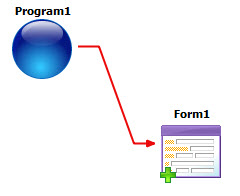Constraints are rules which apply to the relations between items on the BA diagram. If a constraint is not respected on an item, the corresponding error is displayed in the document errors view. During code generation, broken constraints generate errors and stop the generate process with an error status.

Figure 1. Valid relation between Program and CRUD Form
However, if you try to set a relation from a Form entity to a Program, you will
see the constraint icon  indicating that this relation is not valid.
indicating that this relation is not valid.
Each Constraint element manages a constraint on a specific type of relation: Relation, ReportRelation, or WebServiceRelation.
| Attribute | Value | Description |
|---|---|---|
| name | Any string | Name of the constraint. Use to display the name in case of error. |
| reference | Semi-colon separated list such as Relation;ReportRelation;WebServiceRelation | Possible relation types, or * for any. |
| description | Any string | Textual description of the error. |
| source | Semi-colon separated list of source items from which the relation begins, such as ReportData;WebService;Program;Form. | Possible source item types, or * for any. |
| destination | Semi-colon separated list of destination items to which the relation ends, such as Form;Zoom;FormWebService;ZoomWebService. | Possible destination item types, or * for any. |
| minSource |
int >= 0 or ‘*’ for unbounded |
The minimum number of relation sources required for this relation type. Minimum source relation cardinality. |
| maxSource |
int >= 0 or ‘*’ for unbounded |
The maximum number of relation sources allowed for this relation type. Maximum source relation cardinality. |
| minDestination |
int >= 0 or ‘*’ for unbounded |
Minimum destination relation cardinality. |
| maxDestination |
int >= 0 or ‘*’ for unbounded |
The maximum number of relation destinations allowed for this relation type. Maximum destination relation cardinality. If set to 0, this means a relation that meets source and destination constraints cannot be used. |
Example
<Constraint name="Constraint_010" reference="WebServiceRelation" description="Define at least one outgoing relationship from WebServiceServer" source="WebServiceServer" destination="WebService;FormWebService;ZoomWebService" minSource="1"/>
In this example, Constraint_10 specifies that a WebServiceServer source entity must have at least one WebServiceRelation to a destination of WebService, FormWebservice or ZoomWebService.